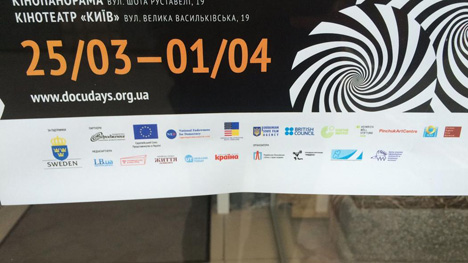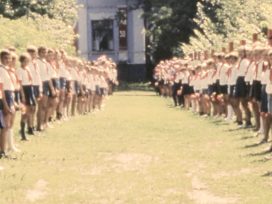
Imperial Russia saw the nation as the sea into which all the other Slavic cultures flowed. The idea persists today not only in Russia’s attitude towards its neighbourhood, but also in the way eastern Europe is studied in the West.
There are few places where the new East-West conflict can be observed so clearly as in Kyiv. The weapons are money, networks and propaganda, writes Harald Neuber. He reports on the silent battle for hearts and minds that’s carried out in public but orchestrated from behind the scenes.
Anyone wishing to visit the headquarters of the new Cold War between the West and Russia has to cross a neglected inner courtyard to the right of the Dnieper and climb a dark stairwell. Behind the glass door, a new world opens up: the brightly lit corridors, well-equipped computer rooms and offices of the Mohyla School of Journalism. It is here, in the small faculty in the old Kyiv neighbourhood of Podil that the Internet portal StopFake.org was established in March 2014, under the aegis of Yevhen Fedchenko.
In this project, around 20 employees deal on a daily basis with reports from Russia that are in fact false, or likely to be so. StopFake.org is one of the visible elements of a silent battle for the hearts and minds of people that is carried out in public but planned behind the scenes. Kyiv is a hotspot for this power play between West and East. It is here that the effects of the struggle between Russia and NATO over media, information and propaganda become apparent in this impoverished, divided and shaken country.
In the Ukrainian capital, the threshold between a frozen and all out conflict has already been overstepped more than once. Not only at the beginning of 2014, when democracy activists, militias and nationalists deposed the pro-Russian president Viktor Yanukovych in an intervention that western PR folk later christened “Euromaidan”. The conflict also became deadly in April 2015, with the murder of the author and journalist Oles Busyna. And in June 2016, when a car bomb killed the journalist Pavel Sheremet at a junction in central Kyiv.

International sources of finance for recent media projects. Photo: Harald Neuber
Journalists get an impression of the polarization during the obligatory training sessions that preface deployment to the warzone in the east of the country, during which “real journalism” is drummed into participants by military personnel and government representatives. And also when foundations, EU offices and NGOs on the one hand, and Russian institutions on the other, set up more or less compliant editorial teams.
However, the Ukrainian media landscape was already anything other than stable, even before the revolution on the Maidan and subsequent upheaval. There are around 16.5 million households in total in Ukraine, most of which depend largely on television for information, a medium controlled by less than a handful of billionaires. Print media could scarcely resist the power of oligarchic TV even before the political upheavals, war in the east and associated crisis: after all, daily newspapers comprised just one per cent of print media and over 80 per cent of newspapers are weeklies. Then there is radio and television, which is dominated by commercial interests. “The country’s six main channels belong to four leading media groups, which are controlled by five oligarchs”, writes journalist Juri Durkot, who is based in the western Ukrainian city of Lviv.
There is so much to do in Ukraine, including with regard to external media support. The conflict between the West and Russia overshadows everything, with press politics being no exception. EU funds and German money too flows to a considerable extent into projects that are understood as being counterpropaganda in the donor states. FakeNews.org, which is devoted to “Ukrainian propaganda too” according to Fedchenko, is among those projects intended to function as a corrective.
“Therefore, we do not take any money from the Ukrainian government either”, says the director of the journalism school, while listing some of the donors: the Soros Foundation, the US-based National Endowment for Democracy and the British embassy. However, that the project, which is intended to be part of the defence against Russian propaganda, is supported in this way has its own implications according to data gathered by the online service Alexa.com, particularly in Russia. “Information”, says Fedchenko, “is more important than the military.”
This insight has obviously won recognition in Berlin too. Of the 38 media projects in Ukraine that the German federal government financed in 2015, 22 were already up and running by October 2016. These were supported by public institutions, Deutsche Welle (propaganda is only ever created by the others), and German universities.
Thus numerous basic media outlets were established in Ukraine in the past year, or were – insofar as they emerged from the Maidan revolution – rescued from bankruptcy. These include Hromadske-Radio and the Internet TV station of the same name. It is purely a matter of chance that the name Hromadske means nothing other than “public”.
The radio station shows how difficult it is to run independent media in Ukraine. After its foundation in autumn 2013, the radio producers ran a crowdfunding campaign that collected as much as 12,000 US dollars. However, the collapse of the country’s currency, the hryvnia, and the crisis led to the flow of donations drying up. “We were then funded for a year by the European Endowment for Democracy, following which, we collected donations again, then the European Union and the embassies of the United States and the Netherlands came to our assistance”, says Kyrylo Loukerenko. For the most part alongside their paid work, his team tries to maintain a non-commercial political channel, which currently broadcasts for around seven hours a day.
Hromadske TV is in a better position, with its headquarters in a modern suite of offices. The “anti-Putin broadcaster”, as the US business magazine Forbes branded it in April 2016, emerged directly from the Maidan protests. Head of documentary films Angelina Kariakina attaches great importance to its independent content, pointing in particular to critical reports on the amnesty law that prevents those who committed crimes during the Maidan protests from being pursued. Most visible however are the anti-Russian contributions that accord with the western narrative. It is therefore no surprise that a Scandinavian ambassador awaits an interview in one of the channel’s corridors or that, a few blocks down, a car belonging to one of the channel’s correspondents is decorated with the black and red colours of the nationalist leader Stepan Bandera.
None of the recently founded media projects in Ukraine can survive without financial assistance from the West. And the political pressure that the donor states and EU apply only increases against the background of the smouldering conflict between NATO and Russia.
In September 2015, the EU created a working group devoted to “strategic communication” in the countries of the so-called Eastern Partnership, that is, those states between the eastern boundary of the union and the Russian Federation’s western border. It was above all the Baltic states and the United Kingdom that insisted on founding the “East StratCom Task Force”, in order to be able to influence public opinion in Ukraine, Georgia, Moldavia, Armenia, Azerbaijan and Belarus. The initiative, which states that it has a network of around 500 informers at its disposal, is supported by the Federal Intelligence Service in Germany (see: “EU parliament demands strategic communication against Russia propaganda”).
While the European Commission’s support group for Ukraine operates in close cooperation with the Task Force, the United States pursues its own media projects. Located outside Kyiv are the headquarters of the US organization Internews, which cooperates closely with the Washington-based United States Agency for International Development (USAID).
Anyone wishing to speak to office manager Wayne Sharp must take a bumpy road through a dacha colony on Kyiv’s periphery. One might begin to suspect that one of the most important USAID operations is based here, upon seeing at the end of the road a couple of limousines, an opaque metal door and the height of the antennae on the roof. Sharp, whose roles as an employee of the US National Democratic Institute have included heading up the communications centre at the Georgian Parliament, is in charge of at least a dozen staff. “Besides media content, we are concerned with press-sector legislation and fighting corruption”, says Sharp, who together with EU partners also organizes programmes in what is now Russian Crimea. What is most important, he says, is to establish TV broadcasters like Hromadske TV, in order to reduce the influence of the large broadcasters.
The battle of the West over public opinion in Ukraine and other states in eastern European and the Baltics has led to the creation of closed networks over the years that have an influence which works in two directions: a new media landscape has emerged in Ukraine that is completely dependent on western donors; as a counterpart to pro-Russian media in the country’s contested east. At the same time however, the organizers and activists of this new media-political sphere play a role in shaping the discourse in the West.
As a journalist, Gemma Pörzgen warns for instance, on the one hand, of the influence of Russian media such as Russia Today and its subsidiary RTDeutsch. In mid-2016, she presented a report as a board member of the organization Reporters Without Borders, concerning the media’s position in Ukraine, which – weakly argued as the report was – indicated an improvement in the situation. Pörzgen then changed her role to that of an expert available to colleagues for interviews.
All this goes to show: Ukraine’s new media landscape faces the threat of being crushed in the struggle between geopolitical interests. The country’s oligarchs with their servile “polit-broadcasters”; a president who has enthroned one of his most trusted advisers at the head of an ominous ministry of information; Russian media power on the one side and, on the other, EU and NATO member states with a programme that is at once public and covert in equal measure. It will scarcely be possible in this complex scenario to set up long-term independent media projects, all the more so as finance from western sources is for the most part only guaranteed for a year and is then evaluated at regular periods.
Over and above careful research, such as that by Kariakina and her colleagues concerning a paramilitary sniper who opened fire on the Maidan protests, or the radio talk shows produced voluntarily by Hromadske Radio, the shrill tones can be heard that insert themselves into the western narrative of necessary counterpropaganda. Or, as Axel Springer’s weekly newspaper Die Welt wrote about StopFake.org: “How one defends oneself against Russian propaganda.”
Published 30 December 2016
Original in English
Translated by
Ben Tendler
Subscribe to know what’s worth thinking about.

Imperial Russia saw the nation as the sea into which all the other Slavic cultures flowed. The idea persists today not only in Russia’s attitude towards its neighbourhood, but also in the way eastern Europe is studied in the West.

Ex-USSR youth pioneer camps – once heavily supervised yet remembered surprisingly positively – have become sites of trauma, where Ukrainian children are being deported en masse, incarcerated and re-educated. The complex legacy that Russia is exploiting encompasses infrastructure, ideology and personal memory, raising questions about the role of individuals in implementing state policy.